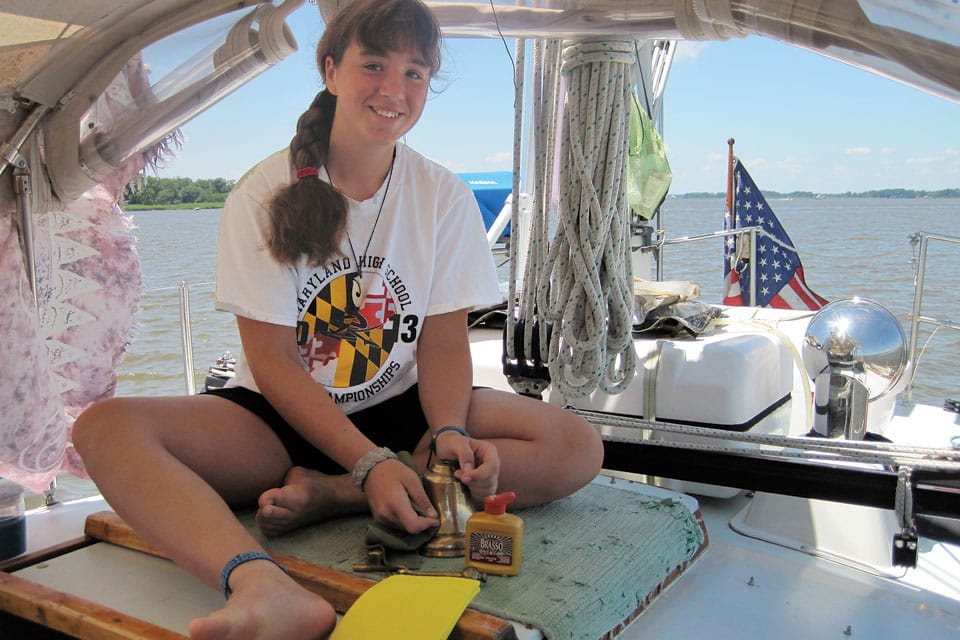
Brasso
Over four years of cruising, as we put equipment to the test aboard Osprey, our Adams 45 steel cutter, we came up with a list of ideas and gear that fall under what’s known as the “pink jobs” category. Unlike the “blue jobs” list (see “Simply Indispensable,” January 2013), this is generally made up of simpler, mostly inexpensive systems or items that just plain work for everyday use. In their own small ways, they make the care and feeding of a family of four on board a little more efficient and easier.
Water Savings
1. Galley saltwater foot pump
This sounds old school, especially on many new boats that seem to want to make people feel like they’re living in a condo, not on a boat. But more than one fellow cruiser has envied ours. They resort to schlepping buckets of saltwater down to the galley to pre-rinse their dishes, or they lug the dishes to the transom to do the same. We just use the saltwater foot pump at the sink, then wash and final rinse with fresh water.
2. Freshwater foot pump (or hand pump) in the galley and head sinks.
This is the partner to number one, and I bring it up because so many boats I see use constant-pressure water in the head and galley. It doesn’t matter how frugal you are; pressure water systems invariably use more water than foot pumps.
Osprey came equipped with a freshwater foot pump for the galley and the head. In the head, hot water is pressure, but cold water (for daily stuff like tooth brushing) is via foot pump. In the galley, we added pressure hot and cold water but we rarely use it. It’s become so much a part of our routine to use the foot pump at either sink. If we want warm water for washing dishes or faces, we just heat it in a tea kettle and pour it in a bowl, rather than run the engine to make hot water and then turn on the pressure water pump to deliver it.
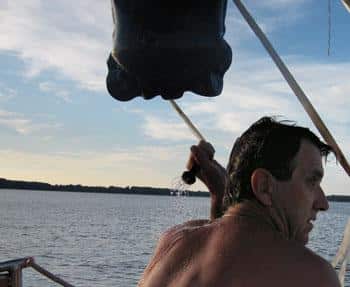
Sun shower
Even though I consider myself a low-maintenance female when it comes to personal buffing and fluffing, my one prerequisite is a hot shower. Daily. Osprey has a terrific shower, but whenever we are in climates and circumstances that permit it, we use the outdoor sun shower, which we hang from the aft arch. It accomplishes two things: One, it uses less water than a pressure-water shower; and two, the sun, rather than the boat’s engine, heats the water. So it’s a triple bonus, minimizing wear and tear on the boat’s hardware, saving fuel and helping conserve what is arguably the world’s most precious resource. We try to keep two on hand, since no matter the manufacturer, they only seem to last a season under heavy use.
In the Galley
4. Carbonated water makers
We don’t drink a lot of soda on Osprey, but we do mix carbonated water with fruit juices, and when you’re sick of Crystal Light and plain water there’s nothing so quenching as an ice-cold ginger ale or orange soda. Many of our cruising friends like the Sodastream system. It does take up counter space, and it’s a challenge to get replacement gas cartridges once you’re out of the country, so load up on them before you head out. We’d grown fond of the iSi Twist ‘n Sparkle, which is a smaller system, but the company has recalled its plastic bottles, citing a risk of bursting. The manufacturer is working on a redesign. For the record, nothing has exploded on Osprey. Either way you go, these eliminate a ton of can and/or bottle trash, and you don’t take up valuable storage space with flats of soda or spend stupid money to buy it in other countries.
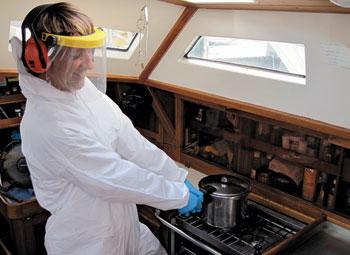
Pressure cooker
This is the most basic piece of galley gear every serious cruising boat should have. They come in all sizes and models, ranging from the simplest jiggler to those with snazzy pressure-relief systems — whatever suits your fancy and comfort level. Osprey is equipped with an older-model Presto. From Presto online I ordered new gaskets and seals, and it works like a champ. Here’s how it makes life easier: You can cook complete one-pot meals hours in advance and they’ll stay warm and secure on the stovetop without having to reheat them. It’s a bonus when sailing in rough weather. You can make a nasty, tough cut of meat tender and tasty; you can cook the potential bacteria out of foods of questionable provenance. A recipe that requires several hours on the stovetop or in the oven can be cooked in a fraction of that time, saving on whatever cooking gas you’re using.
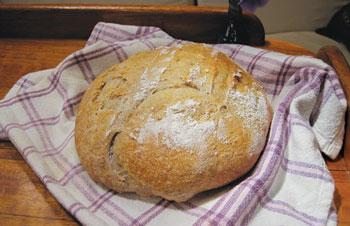
Recipes from Artisan Bread in Five Minutes a Day ** by Jeff Hertzberg and Zoë François
This book explains a method for quickly making excellent bread with no kneading that helped me keep a hungry family fed when we were sailing in remote areas that were short on just about every food staple but flour. You need enough space in your fridge for a plastic container of at least four quarts: I use a vertical rectangular container and there’s still plenty of room for everything else. This is where you toss the ingredients — flour, water, salt, yeast — mix, let rise once, and refrigerate for up to a week.
When you want a quick loaf of delicious, crusty bread, you pull out a hunk of the dough, shape it, let it rise 20 minutes, and then bake it in a hot oven for half an hour. The book recommends you use a pizza or bread stone; we bought one and cut it down to fit Osprey‘s stove. But my friend Julie has also had success simply using a cast-iron frying pan that she pre-heats, and you can also just use standard bread pans.
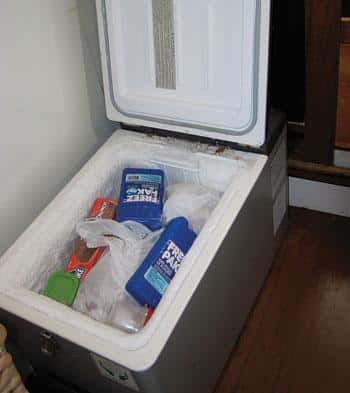
Stand-alone 12-volt freezer
Osprey has 12-volt cold-plate refrigeration, and if you lay something right against the plates eventually it’ll freeze. But it’s not a practical method, nor can you freeze a lot of stuff. We debated installing a full freezer but then had the good sense to learn from our friends, who raved about their Waeco 12-volt freezer. This cooler-size unit lived beneath their saloon table and easily froze meats, cheeses, ice and ice cream. We used a Waeco for the first three years and it performed admirably. In this last year we have switched to an Engel, which we like even more because it seems more efficient and sweats less than the Waeco did in humid climes.
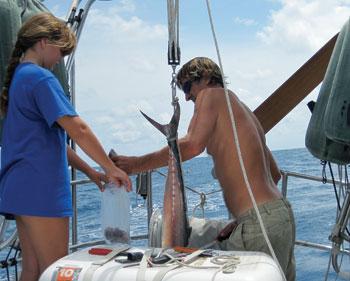
Food vacuum-bagging system
There are several brands; we bought a FoodSaver because Sam’s Club carried it and the proprietary bags in quantity. We use this versatile tool all the time. When we catch fresh fish that’s too big to eat in one or two meals, we can instantly vacuum bag and freeze it. Likewise, I can buy bulk quantities of meats, divide them into smaller portions and freeze them. Vacuum bagging eliminates freezer burn, and it also compresses the food so that you can fit more into the freezer. I also use it to seal and store coffee, flour, sugar, pasta and anything else that bugs can otherwise get into. Johnny has even used it to seal tools, spare watermaker filters and any other parts that he doesn’t want exposed to salt air.
9. Galley chamois and cloth napkins
Living in a house I routinely bought truck-size quantities of paper towels. On a boat, I lack the space, and in many countries paper products cost twice as much as they do in the U.S. Both reasons were incentive enough to try out Trader Joe’s Super Amazing Kitchen Cloths. These are like chamois cloths for the galley, and at $4 for a two-pack it’s hard to go wrong. They’ve completely eliminated the need for paper towels, with the exception of when we check the engine oil (we keep one roll for that). We use the cloths for cleaning all surfaces throughout the boat, inside and outside. When they’re dirty, we wash, dry and reuse. Saves on trash, saves on trees, saves on money. Likewise, we now use cloth napkins that we make from quilting scrap remnants you can buy cheaply at any fabric store, and you can use the same thing for wrapping paper.
10. Portable spin dryer and washer
These are on my wish list, because I haven’t figured out a place to store them on Osprey, but I have enough cruising friends who’ve had great success with them that I feel confident recommending them.
There are several brands; my friends swear by the Wonder Wash from the Laundry Alternative. It’s a little hand-cranked washing machine that uses only elbow grease and minimal fresh water. Then, switch to the Laundry Alternative Spin Dryer, which does use 110-volt AC, but spins your clothes nearly dry in a couple of minutes, so a half-hour on the lifelines does the rest. I could recoup the cost of these nifty machines in maybe six laundromat trips in a destination like the Bahamas. These tools are a lot more fun than hand-washing in a drywall bucket, believe me.
Communications
11. Yotreps
This wonderful service, provided by Pangolin, a New Zealand-based website, costs nothing and enables family and friends to follow your track anywhere in the world, as long as you have an SSB and Sailmail or Winlink to send position updates. By registering your boat and sending daily position reports, you provide weather and sea state information to other sailors, and those at home with an Internet connection simply click on your boat’s name to see where you are. A Google Earth map pinpoints your latest position with whatever pithy little report you wish to add (it limits you to 80 characters).
12. Powered Wi-Fi antenna with router
A powered Wi-Fi antenna that you run up a halyard can mean the difference between handling email and surfing the Web comfortably at anchor or dinghying ashore to spend hours in some dirt-floored hut sweating onto your keyboard. Likewise, an onboard router makes it seamlessly easy for more than one computer to access the Internet at once, thereby preventing nasty territory disputes among spouses and siblings. There are many options for these; on Osprey we use an all-weather Ubiquiti Bullet and POE (power over Ethernet, which powers the system), a multidirectional antenna and a standard Cisco router. The whole system costs about $200 and can reach out and touch Wi-Fi sources several miles away.
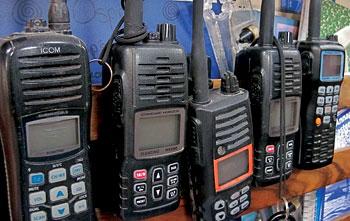
Handheld VHFs
These are the cellphones of the cruising family. Get a lot of them. It doesn’t really matter what brand. Especially when you have kids who spend a lot of time on the beach, running around and dropping stuff in the water; they’re vital for staying in touch and they take a beating. We used to have two; now we have four. Two for standard use, and two for backup. And we’ve had to use all four, at one time or another.
Osprey has landed for a while on the Chesapeake Bay and its crew is between voyages. This article first appeared as “Make it Easy” in the October 2013 issue of Cruising World.








